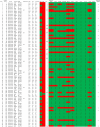Characterization of Staphylococcus aureus isolated from milk samples for their virulence, biofilm, and antimicrobial resistance
- PMID: 39465266
- PMCID: PMC11514165
- DOI: 10.1038/s41598-024-75076-y
Characterization of Staphylococcus aureus isolated from milk samples for their virulence, biofilm, and antimicrobial resistance
Abstract
The Staphylococcus aureus (S. aureus) one of the important food borne pathogen from milk, which was investigated in this study. The isolates were screened for antimicrobial resistance, enterotoxin genes, biofilm formation, spa typing, coagulase gene polymorphism and accessory gene regulator types. The prevalence of S. aureus in milk samples was 34.4% (89/259). Methicillin resistant S. aureus (MRSA) was found at 27% (24/89) of the isolates, were classified as community acquired based on SCCmec typing. The 24.71% (22/89) isolates demonstrated multiple antimicrobial resistance (MAR) pattern. However, none of the isolates carried vancomycin and mupirocin resistance genes. The isolates were positive for sea and sed enterotoxin genes and exhibited high frequency of biofilm formation. The High-Resolution Melting and conventional spa typing revealed that the isolates had both animal and community-associated S. aureus clustered origins. Coagulase gene polymorphism and agr typing demonstrated variable genotypic patterns. The finding of this study establishes the prevalence of community associated, enterotoxigenic, biofilm forming and antimicrobial resistance among S. aureus from milk in Chennai city. This emphasizing a potential threat to public health which needs a continuous monitoring system and strategies to mitigate their spread across the food chain and achieve food safety.
Keywords: Spa typing; Staphylococcus aureus; Antimicrobial resistance (AMR); Biofilm; Coagulase gene; Enterotoxin; High Resolution Melting (HRM).
© 2024. The Author(s).
Conflict of interest statement
The authors declare no Competing interests
Figures




References
-
- Thompson, T. A. & Brown, P. D. Association between the agr locus and the presence of virulence genes and pathogenesis in Staphylococcus aureus using a Caenorhabditis elegans model. Int. J. Infect. Dis.54, 72–76. 10.1016/j.ijid.2016.11.411 (2017). - PubMed
MeSH terms
Substances
LinkOut - more resources
Full Text Sources

